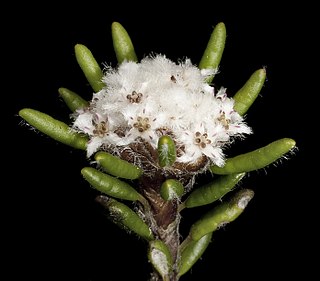Stenanthemum bremerense is a species of flowering plant in the family Rhamnaceae and is endemic to the southwest of Western Australia. It is an erect, or low spreading shrub with hairy young stems, broadly egg-shaped leaves and densely hairy heads of tube-shaped flowers, sometimes with whitish floral leaves.
Stenanthemum divaricatum is a species of flowering plant in the family Rhamnaceae and is endemic to the southwest of Western Australia. It is a small, often spiny shrub with sparsely hairy young stems, fan-shaped to narrowly egg-shaped leaves and densely, softly-hairy heads of tube-shaped flowers.

Stenanthemum humile is a species of flowering plant in the family Rhamnaceae and is endemic to the southwest of Western Australia. It is a low, erect perennial herb or shrub with white, woolly-hairy young stems, linear to narrowly elliptic leaves and densely, woolly-hairy heads of tube-shaped flowers.

Stenanthemum intricatum is a species of flowering plant in the family Rhamnaceae and is endemic to the southwest of Western Australia. It is an erect to spreading, often wiry shrub with sparsely hairy young stems, egg-shaped to fan-shaped leaves and greyish, densely softly-hairy heads of white or cream-coloured flowers.
Stenanthemum liberum is a species of flowering plant in the family Rhamnaceae and is endemic to the southwest of Western Australia. It is a dwarf or prostrate shrub with densely hairy young stems, elliptic to egg-shaped with the narrower end towards the base, and densely hairy heads of tube-shaped flowers.
Stenanthemum limitatum is a species of flowering plant in the family Rhamnaceae and is endemic to the southwest of Western Australia. It is an erect or straggling shrub with sparsely hairy young stems, egg-shaped to fan-shaped leaves and greyish, softly-hairy heads of white or cream-coloured flowers.
Stenanthemum mediale is a species of flowering plant in the family Rhamnaceae and is endemic to inland Western Australia. It is an erect shrub with densely hairy young stems, egg-shaped leaves and densely hairy heads of silvery to rust-coloured flowers.

Stenanthemum nanum is a species of flowering plant in the family Rhamnaceae and is endemic to the south-west of Western Australia. It is a prostrate shrub with hairy young stems, broadly egg-shaped leaves with the narrower end towards the base, and densely silvery-hairy heads of white or cream-coloured flowers.
Cryptandra minutifolia is a flowering plant in the family Rhamnaceae and is endemic to the south-west of Western Australia. It is a spreading shrub with oblong to elliptic leaves and clusters of white or pink, tube-shaped flowers.
Stenanthemum newbeyi is a species of flowering plant in the family Rhamnaceae and is endemic to a restricted area in the south of Western Australia. It is an erect or spreading shrub with hairy young stems, egg-shaped leaves with the narrower end towards the base, and clusters of rust-coloured, densely shaggy-hairy flowers, surrounded by whitish floral leaves.
Stenanthemum patens is a species of flowering plant in the family Rhamnaceae and is endemic to the inland of Western Australia. It is a small shrub with densely hairy young stems and a few spines, egg-shaped to broadly egg-shaped leaves with the narrower end towards the base, and densely hairy clusters of tube-shaped flowers.
Stenanthemum petraeum is a species of flowering plant in the family Rhamnaceae and is native to inland Western Australia and the Northern Territory. It is a woody, erect shrub with densely hairy young stems, broadly egg-shaped to more or less round leaves, and clusters of white, densely shaggy- to woolly-hairy flowers.
Stenanthemum poicilum is a species of flowering plant in the family Rhamnaceae and is endemic to the south-west of Western Australia. It is an erect or low-lying shrub with hairy young stems, broadly egg-shaped leaves with the narrower end towards the base, and clusters of densely hairy white flowers.

Stenanthemum pomaderroides is a species of flowering plant in the family Rhamnaceae and is endemic to the southwest of Western Australia. It is an erect shrub with densely hairy young stems, egg-shaped leaves with the narrower end towards the base, and cream-coloured clusters of 10 to 30 tube-shaped flowers.

Stenanthemum pumilum is a species of flowering plant in the family Rhamnaceae and is endemic to the southwest of Western Australia. It is a low, compact shrub with hairy young stems, egg-shaped leaves, sometimes with the narrower end towards the base, and clusters of 10 to 30 white to creamy-white, woolly hairy, tube-shaped flowers.
Stenanthemum radiatum is a species of flowering plant in the family Rhamnaceae and is endemic to a restricted part of the southwest of Western Australia. It is a spreading shrub with narrowly triangular or wedge-shaped to heart-shaped leaves and densely crowded, head-like clusters of white, densely hairy, tube-shaped flowers.

Stenanthemum reissekii is a species of flowering plant in the family Rhamnaceae and is endemic to the south-west of Western Australia. It is an erect or low-lying shrub with hairy young stems, egg-shaped or narrowly egg-shaped leaves with the narrower end towards the base, and clusters of densely hairy white or cream-coloured flowers.
Stenanthemum stipulosum is a species of flowering plant in the family Rhamnaceae and is endemic to inland Western Australia. It is an erect or low-lying shrub with densely hairy young stems, egg-shaped with the narrower end towards the base, and clusters of 10 to 30 densely hairy white or cream-coloured flowers, sometimes surrounded by whitish floral leaves.
Stenanthemum sublineare is a species of flowering plant in the family Rhamnaceae and is endemic to the southwest of Western Australia. It is an erect shrub with sparsely hairy young stems, narrowly egg-shaped to linear leaves, and small clusters of densely hairy, greenish, tube-shaped flowers.
Stenanthemum yorkense is a species of flowering plant in the family Rhamnaceae and is endemic to an area near York in the southwest of Western Australia. It is a low, spreading shrub with egg-shaped leaves, the narrower end towards the base, and densely crowded, head-like clusters of white, tube-shaped flowers with a yellow centre.





